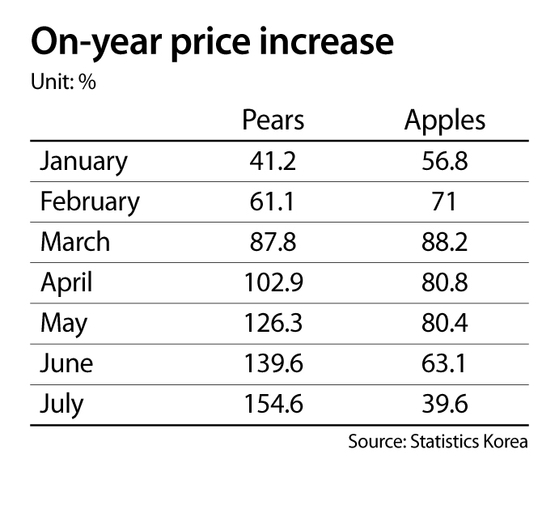Explainer: How orchards wither, oceans boil, and price tags soar
Published: 03 Aug. 2024, 07:18
Updated: 03 Aug. 2024, 14:30
-

- SHIN HA-NEE
- shin.hanee@joongang.co.kr
![Rotten apples litter the ground at an apple orchard in Miryang, South Gyeongsang, on September 11, 2023. [NEWS1]](https://koreajoongangdaily.joins.com/data/photo/2024/08/03/e98547e6-5c64-47b1-8e9a-26b20cd6617f.jpg)
Rotten apples litter the ground at an apple orchard in Miryang, South Gyeongsang, on September 11, 2023. [NEWS1]
Korea’s economic and business scenes unfold in such an intricate way that the headline numbers and official statements fall short of explaining what is really happening and why it matters. The Korea JoongAng Daily’s Explainer series aims to address the largely-unmet yet crucial need with an angle relevant to our readers across the globe. — ED
Fruit enthusiasts encountered a somber report this year foreboding that apples, Korea’s favorite fruit, may be uncultivable on the peninsula within the next half-century.
The projection from the Rural Development Administration also showed that pears, peaches and grapes will likely face a similar fate by 2050 as the warming climate shrinks the land suitable for orchards.
But the crisis is not a distant threat; it is a stark reality, as apples and pears, the once budget-friendly fruit duo, have turned into luxury items as of late due to double- to triple-digit hikes in prices.
Pears, in particular, underwent a whopping 154.6 percent on-year price surge in July — the biggest yearly jump ever recorded. The unprecedented spike has significantly hampered exports as well; From January to June, Korea’s pear export volume plunged by 70 percent from the same period a year earlier to $5.3 million, knocking it off its long-held top spot as the country's top fruit export.
Agricultural farms are not the only ones suffering from extreme weather conditions. As the ocean heats up, the prices of some seafood products such as seaweed surged, while hundreds of thousands of heads of livestock died due to boiling temperatures this summer.
As Korea, along with the rest of the world, grapples with the unprecedented climate crisis, here are some of the burning questions about the future of our dinner tables, and the planet that sustains us.
Q. How did extreme weather drive up fresh food prices?
A. The recent surges in pear and apple prices were caused by unseasonably warm temperatures last year, which resulted in a significant drop in production.
Pear and apple blossoms bloomed about 10 days earlier than usual due to the abnormally warm temperatures in March of last year. Such premature blooming exposed the blossoms to frost and sudden temperature drops during early spring, which led to a reduced yield.
![Pears lie on the ground at an orchard in Suncheon, South Jeolla, on August 10, 2023. [YONHAP]](https://koreajoongangdaily.joins.com/data/photo/2024/08/03/60cb1c3a-1dd8-4d5a-9002-80f18f779870.jpg)
Pears lie on the ground at an orchard in Suncheon, South Jeolla, on August 10, 2023. [YONHAP]
Apple and pear production dropped by 16.5 percent and 31.8 percent from a year earlier in 2023, driving up prices throughout this year, according to data compiled by the Agricultural Policy Insurance & Finance Service.

Strained by a reduced yield, pear prices have been up throughout this year, logging unprecedentedly steep increases of 139.6 percent in June and 154.6 percent last month. Apple prices also rose 39.6 percent in July and 63.1 percent in June, after reporting on-year increases of more than 80 percent for three consecutive months. The price has begun to stabilize gradually as apples newly harvested this year began to hit the market.
Fisheries have also been affected by warming weather as higher temperatures heat oceans. The National Institute of Fisheries Science expected that the waters around the Korean Peninsula would be about 1 degree Celsius (1.8 degrees Fahrenheit) hotter this summer on average compared to a normal year. Over the past eight years, aquaculture farms reported damages amounting to 202.4 billion won ($147.5 million) due to die-offs caused by high temperatures.
Rare heavy rainfall during the last monsoon season, which the chief of the Korea Meteorological Administration described as an “extreme weather event that can only be explained by climate change,” spurred prices of some agricultural products, including lettuce, to skyrocket through July as well.
![A shopper looks at cutlassfish fillets at a discount mart on April 21. The cutlassfish catch dropped by 70 percent in April this year due to higher water temperatures. [YONHAP]](https://koreajoongangdaily.joins.com/data/photo/2024/08/03/82fc7cd3-47a9-40ec-8e94-481882f8523f.jpg)
A shopper looks at cutlassfish fillets at a discount mart on April 21. The cutlassfish catch dropped by 70 percent in April this year due to higher water temperatures. [YONHAP]
Will apples become uncultivable in Korea?
While last year’s reduced fruit yields were caused by abnormal and unpredictable weather events, the Rural Development Administration’s report warned that most of the land in Korea will become fundamentally inadequate for apple cultivation if the current pace of climate warming persists.
The March report predicted a gradual decline in land suitable for apple orchards, which is mostly concentrated in the central regions of the country, starting in 2030. By 2050, apple cultivation is expected to be limited to only the Gangwon region, and by 2070, nearly all of the land in Korea might become inadequate for apple farming.
In this scenario, tangerine farming, which is now primarily concentrated in the southernmost parts of Korea like Jeju Island, would be feasible across the country.
To mitigate growing fruit price volatility in both the short and long terms, the government announced a seven-year plan in April. The plan includes deploying preventive measures against abnormal weather for 30 percent of apple and pear farms and cultivating new apple farmlands in the Gangwon region, which is expected to be less affected by climate warming.
“Through the latest plan, we aim to change the paradigm of fruit farming by shifting the industry's current focus on 'premiumization' to climate risk mitigation,” said the Ministry of Agriculture, Food and Rural Affairs.
The Agriculture Ministry also plans to develop new varieties of apples and smart farming technologies to improve efficiency in fruit production.
How does the climate crisis affect consumer prices?
According to the Bank of Korea’s report on the impact of climate change on domestic inflation published on July 2, a temporary 1-degree increase in temperature is estimated to drive agricultural prices by 0.4 to 0.5 percentage points, which would have a lingering impact for the following six months.
If the average temperature stays 1 degree above the long-term average between 1973 to 2023 for a year, agricultural product prices are expected to grow by 2 percent, and the consumer price index by 0.7 percent.
"As abnormal weather patterns have grown more frequent lately, climate-driven inflation is becoming a reality,” said Cho Byeong-soo, a Bank of Korea researcher on the consumer price research team.
"The government needs to put effort into developing new varieties of agricultural products adequate for changing weather conditions, while the central bank should bolster its management of inflation expectations among economic players so that climate-driven price fluctuation does not lead to overall price instabilities.”
BY SHIN HA-NEE [shin.hanee@joongang.co.kr]










with the Korea JoongAng Daily
To write comments, please log in to one of the accounts.
Standards Board Policy (0/250자)